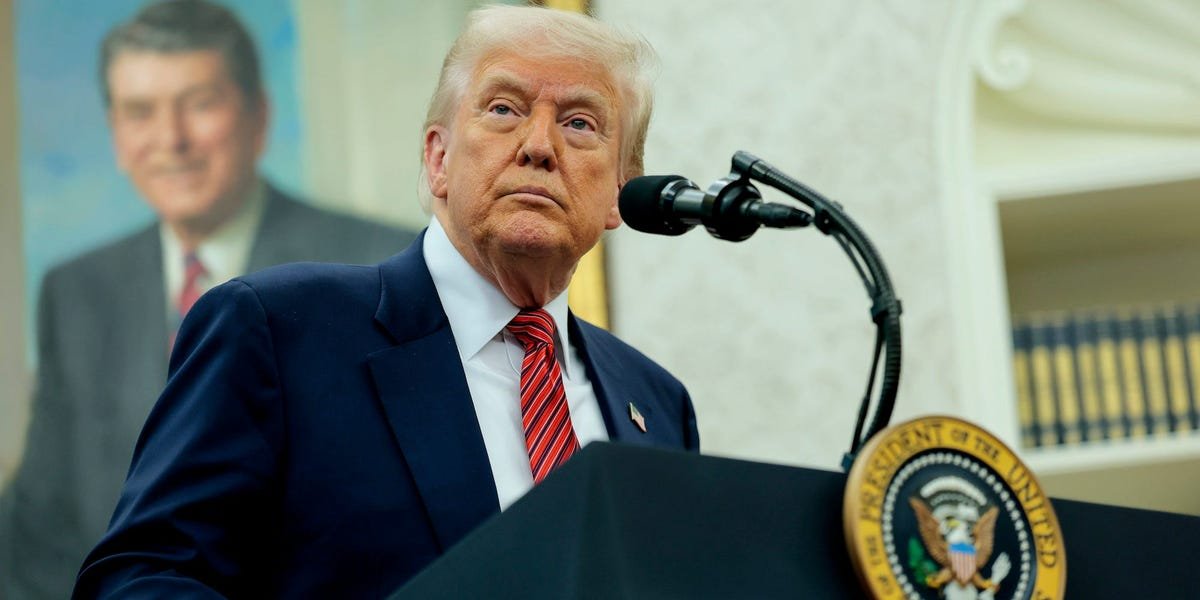
Take a look at our newest merchandise
President Donald Trump’s plans to dismantle the Division of Training can formally be revived.
On Monday, the Supreme Courtroom stated that Trump’s administration can transfer ahead with its plan to terminate over 1,300 of the Division of Training’s workers. Previous to the terminations, the division had 4,133 employees on employees. After the division introduced in March that it deliberate to slash half of its workforce, a federal decide in Could blocked these plans from transferring ahead indefinitely.
The Supreme Courtroom’s Monday ruling briefly suspends that federal decide’s block whereas the authorized course of performs out. The three liberal judges dissented.
“As we speak, the Supreme Courtroom once more confirmed the plain: the President of america, as the pinnacle of the Government Department, has the last word authority to make choices about staffing ranges, administrative group, and day-to-day operations of federal businesses,” Linda McMahon, Trump’s training secretary, stated in a press release.
“Whereas at this time’s ruling is a big win for college kids and households, it’s a disgrace that the very best court docket within the land needed to step in to permit President Trump to advance the reforms People elected him to ship utilizing the authorities granted to him by the U.S. Structure,” she continued.
Justice Sonia Sotomayor wrote in her dissent that the choice expedites “lawlessness” within the government department.
“The bulk is both willfully blind to the implications of its ruling or naive, however both approach the risk to our Structure’s separation of powers is grave,” Sotomayor stated.
This is what this ruling means for the way forward for the Division of Training.
What dismantling ED would imply for student-loan debtors and colleges
McMahon has repeatedly acknowledged that, regardless of Trump’s order to remove the division, closing a federal company can’t be performed with out approval from Congress.
The federal decide who blocked the division’s discount efforts in Could wrote in his ruling that there is no proof to counsel the administration’s intent to work with Congress.
“Not solely is there no proof that Defendants are pursuing a ‘legislative aim’ or in any other case working with Congress to achieve a decision, however there’s additionally no proof that the RIF has truly made the Division extra environment friendly,” the ruling stated, referring to employee firings, formally known as reduction-in-force. “Slightly, the file is replete with proof of the alternative.”
The division primarily facilitates federal funding and analysis and manages a trillion-dollar student-loan portfolio. Cuts to division employees would make managing these packages harder, training analysts beforehand stated, and plenty of packages counting on grants and pupil support would seemingly see extra in depth delays and paperwork processing backlogs.
Whereas Trump instructed in March that he needed to switch pupil loans to a different federal company, it is unclear how rapidly the administration is working to make that occur, if in any respect.
Trump additionally minimize $900 million in analysis contracts in February, and training consultants beforehand advised Enterprise Insider that the cuts are placing future knowledge assortment — together with the power to trace youngsters’ progress in science and studying — in danger.
Sheria Smith, president of the American Federation of Authorities Workers native chapter representing Division of Training employees, stated in a press release that the ruling “is enjoying with the futures of hundreds of thousands of People, and after simply 4 months, the results are already evident throughout our training system.”
“It is deeply disappointing that the Supreme Courtroom is upholding this excessive, anti-democratic agenda, regardless of this administration’s clear obstruction of civil rights and its misalignment with the Structure,” Smith stated.
In her assertion, McMahon stated that workforce reductions will now proceed “to advertise effectivity and accountability and to make sure sources are directed the place they matter most — to college students, dad and mom, and academics.”

![[Netflix Certified & Auto Focus] Smart 4K Projector, VGKE 900 ANSI Full HD 1080p WiFi 6 Bluetooth Projector with Dolby Audio, Fully Sealed Dust-Proof/Low Noise/Outdoor/Home/Bedroom](https://i0.wp.com/m.media-amazon.com/images/I/71yY+2ryOZL._AC_SL1500_.jpg?w=300&resize=300,300&ssl=1)
![[Netflix Official & Auto Focus/Keystone] Smart Projector 4K Support, VOPLLS 25000L Native 1080P WiFi 6 Bluetooth Outdoor Projector, 50% Zoom Home Theater Movie Projectors for Bedroom/iOS/Android/PPT](https://i2.wp.com/m.media-amazon.com/images/I/71Emwd78tlL._AC_SL1500_.jpg?w=300&resize=300,300&ssl=1)



![[Win 11&Office 2019] 14″ Rose Gold FHD IPS Display Ultra-Thin Laptop, Celeron J4125 (2.0-2.7GHz), 8GB DDR4 RAM, 1TB SSD, 180° Opening, 2xUSB3.0, WIFI/BT, Perfect for Travel, Study and Work (P1TB)](https://i3.wp.com/m.media-amazon.com/images/I/71CzO7Oc8jL._AC_SL1500_.jpg?w=300&resize=300,300&ssl=1)








